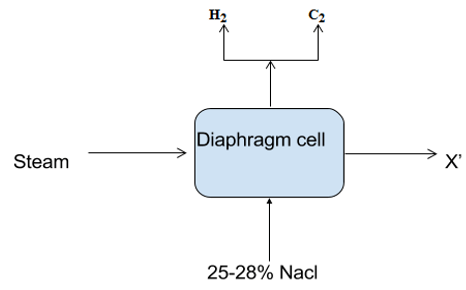This set of Chemical Industry Multiple Choice Questions & Answers (MCQs) focuses on “Inorganic Chemical – Chloro – Alkali Industries”.
1. Which one mentioned below is not a major industrial chemical produced by chloro-alkali industry?
a) Soda ash
b) Caustic soda
c) Chlorine
d) Ammonium carbonate
View Answer
Explanation: The chloro alkali industry represents production of three major industrial chemicals:
Soda ash(sodium carbonate), caustic soda(sodium hydroxide), chlorine(Cl2). Thus ammonium carbonate is not a chloro-alkali product.
2. Which one is dual process?
a) Na2CO3+NH4Cl
b) Na2CO3+NaCl
c) NH4Cl+Ca(OH)2
d) CaCO3+NaCl
View Answer
Explanation: Ammonium chloride and calcium hydroxides reacts in solvay process along with calcium carbonate and sodium chloride while sodium carbonate and ammonium chloride reacts in dual process.
3. What is the input bulk requirements for the solvay process?
a) Salt, coal and water
b) Salt, coal and limestone
c) Salt, limestone and water
d) Coal, limestone and water
View Answer
Explanation: Input bulk requirements for the solvay process are salt, coal and limestone Salt is used as brine pumped from deep walls or as crystalline sat via evaporation procedures.
4. In solvay process, where purified brine is pumped?
a) CO absorber tower
b) H2O absorber tower
c) NH3 absorber tower
d) Carbonation tower
View Answer
Explanation: In solvay or ammonia-soda process, the purified brine is pumped to the ammonia absorber tower where it dissolves NH3 with liberation of heat. Some CO2 also dissolves in this tower.
5. What is the modification of the dual process?
a) Recovery of NH4Cl as co-product
b) Recovery of NH3 as co-product
c) Recovery of NaHCO3 as co-product
d) Recovery of NH34(NO3) as co-product
View Answer
Explanation: The principal modification of the dual process is the recovery of NH4Cl as a co-product rather than the liberation of the contained ammonia for recycle as in the solvay process.
6. What is the disadvantage of solvay process?
a) No co-products to dispose
b) Use of low-grade brine
c) Higher salt consumption
d) Low corrosion problems
View Answer
Explanation: The advantages of solvay process are-can use low-grade brine, less electric power, less corrosion problems, no co-products to dispose while disadvantages are higher salt consumption, more stream consumption etc.
7. Which one is a NaOH process with no Cl2 co-product?
a) HCl-air oxidation with Fe2O3
b) HCl-air-Cl2 oxychlorination
c) HNO3-Nacl-air process
d) Na2CO3– Ca(OH)2
View Answer
Explanation: Na2CO3-Ca(OH)2 process is the production of NaOH with no Cl2 co-product while HCl-air oxidation with Fe2O3 catalyst, HCl-air-Cl2 oxychlorination process are the production chlorine without any co-products.
8. Where ‘denuding’ is occur_______
a) Diaphragm cell
b) Mercury cell
c) Membrane cell
d) Voltaic cell
View Answer
Explanation: Denuding reaction occurs in the mercury cell of electrolytic process of chlorine production. In denuding reaction amalgam reacts with water to produce sodium hydroxide, hydrogen and chlorine.
9. Why minor quantities of Na2CO3 required in electrolysis process?
a) For Cl2 drying
b) For high purity brine
c) For salt purification
d) For high purity depleted brine
View Answer
Explanation: Electrolysis process of chlorine production contains diaphragm cell and mercury cell. In this process,minor quantities of Na2CO3 and NaOH required for the salt purification while H2SO4 is required for Cl2 drying.
10. What is ‘X’ in the following flow chart?

a) Caustic soda and NaCl
b) Only caustic soda
c) Caustic soda and NaOH
d) Caustic soda and C2
View Answer
Explanation: In this process,saturated brine (25-28% NaCl) is heated and electrolyzed in a diaphragm cell. The cell, operating at 45-55% decomposition efficiency, discharges a 10-12% solution of caustic soda with about an equal concentration of NaCl.
Sanfoundry Global Education & Learning Series – Chemical Industry.
To practice all areas of Chemical Industry, here is complete set of 1000+ Multiple Choice Questions and Answers.
If you find a mistake in question / option / answer, kindly take a screenshot and email to [email protected]
- Apply for Chemical Engineering Internship
- Practice Chemical Engineering MCQs
- Check Chemical Process Technology Books
- Check Chemical Engineering Books
